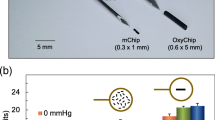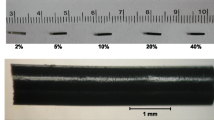Abstract
Oxygen-sensing implants, composed of paramagnetic microcrystals embedded in a biocompatible polymer, are increasingly being used for electron paramagnetic resonance (EPR) oximetry in animal models and human subjects. The implants are stable and designed to stay in the tissues for indefinite periods. However, it is not known whether the crystals that may be exposed on the surface of the implants or leached out from the implants will induce cytotoxicity thereby compromising their biocompatibility over the long term. The goal of the current study was to evaluate the cytotoxicity of the implants and crystalline particulates under in vitro conditions. Apoptosis and cell viability studies were performed using L6, a rat muscle cell line and AsPC-1, a cancer cell line derived from human pancreatic adenocarcinoma. The results indicated that neither the intact implants nor their components elicit cytotoxicity, thus establishing their biocompatibility for use in human subjects.



Similar content being viewed by others
References
Ahmad, R., & Kuppusamy, P. (2010). Theory, instrumentation, and applications of electron paramagnetic resonance oximetry. Chemical Reviews, 110(5), 3212–3236.
Swartz, H. M., Hou, H., Khan, N., Jarvis, L. A., Chen, E. Y., Williams, B. B., & Kuppusamy, P. (2014). Advances in probes and methods for clinical EPR oximetry. Advances in Experimental Medicine and Biology, 812, 73–79.
Hou, H., Khan, N., Gohain, S., Kuppusamy, M. L., & Kuppusamy, P. (2018). Pre-clinical evaluation of OxyChip for long-term EPR oximetry. Biomedical Microdevices, 20(2), 29.
Pandian, R. P., Parinandi, N. L., Ilangovan, G., Zweier, J. L., & Kuppusamy, P. (2003). Novel particulate spin probe for targeted determination of oxygen in cells and tissues. Free Radical Biology and Medicine, 35(9), 1138–1148.
Kmiec, M. M., Tse, D., Mast, J. M., Ahmad, R., & Kuppusamy, P. (2019). Implantable microchip containing oxygen-sensing paramagnetic crystals for long-term, repeated, and multisite in vivo oximetry. Biomedical Microdevices, 21(3), 71.
Kmiec, M. M., Hou, H., Lakshmi Kuppusamy, M., Drews, T. M., Prabhat, A. M., Petryakov, S. V., Demidenko, E., Schaner, P. E., Buckey, J. C., Blank, A., & Kuppusamy, P. (2019). Transcutaneous oxygen measurement in humans using a paramagnetic skin adhesive film. Magnetic Resonance in Medicine, 81(2), 781–794.
Pandian, R. P., Raju, N. P., Gallucci, J. C., Woodward, P. M., Epstein, A. J., & Kuppusamy, P. (2010). A new tetragonal crystalline polymorph of lithium octa-n-butoxy-naphthalocyanine (LiNc-BuO) radical: structural, magnetic and oxygen-sensing properties. Chemistry of Materials, 22, 6254–6262.
Mohan, I. K., Khan, M., Wisel, S., Selvendiran, K., Sridhar, A., Carnes, C. A., Bognar, B., Kalai, T., Hideg, K., & Kuppusamy, P. (2009). Cardioprotection by HO-4038, a novel verapamil derivative, targeted against ischemia and reperfusion-mediated acute myocardial infarction. American Journal of Physiology. Heart and Circulatory Physiology, 296(1), H140–H151.
Chacko, S. M., Khan, M., Kuppusamy, M. L., Pandian, R. P., Varadharaj, S., Selvendiran, K., Bratasz, A., Rivera, B. K., & Kuppusamy, P. (2009). Myocardial oxygenation and functional recovery in infarct rat hearts transplanted with mesenchymal stem cells. American Journal of Physiology Heart and Circulatory Physiology, 296(5), H1263–H173.
Fisher, E. M., Khan, M., Salisbury, R., & Kuppusamy, P. (2013). Noninvasive monitoring of small intestinal oxygen in a rat model of chronic mesenteric ischemia. Cell Biochemistry and Biophysics, 67(2), 451–459.
Khan, M., Kutala, V. K., Vikram, D. S., Wisel, S., Chacko, S. M., Kuppusamy, M. L., Mohan, I. K., Zweier, J. L., Kwiatkowski, P., & Kuppusamy, P. (2007). Skeletal myoblasts transplanted in the ischemic myocardium enhance in situ oxygenation and recovery of contractile function. American Journal of Physiology Heart and Circulatory Physiology, 293(4), H2129–H2139.
Khan, M., Meduru, S., Mohan, I. K., Kuppusamy, M. L., Wisel, S., Kulkarni, A., Rivera, B. K., Hamlin, R. L., & Kuppusamy, P. (2009). Hyperbaric oxygenation enhances transplanted cell graft and functional recovery in the infarct heart. Journal of Molecular and Cellular Cardiology, 47(2), 275–287.
Khan, M., Meduru, S., Pandian, R. P., Rivera, B. K., & Kuppusamy, P. (2011). Effect of oxygenation on stem-cell therapy for myocardial infarction. Advances in Experimental Medicine and Biology, 701, 175–181.
Khan, M., Mohan, I. K., Kutala, V. K., Kotha, S. R., Parinandi, N. L., Hamlin, R. L., & Kuppusamy, P. (2009). Sulfaphenazole protects heart against ischemia-reperfusion injury and cardiac dysfunction by overexpression of iNOS, leading to enhancement of nitric oxide bioavailability and tissue oxygenation. Antioxidants & Redox Signaling, 11(4), 725–738.
Ohanyan, V., Yin, L., Bardakjian, R., Kolz, C., Enrick, M., Hakobyan, T., Kmetz, J., Bratz, I., Luli, J., Nagane, M., Khan, N., Hou, H., Kuppusamy, P., Graham, J., Fu, F. K., Janota, D., Oyewumi, M. O., Logan, S., Lindner, J. R., & Chilian, W. M. (2015). Requisite role of Kv1.5 channels in coronary metabolic dilation. Circulation Research, 117(7), 612–621.
Prabhat, A. M., Kuppusamy, M. L., Naidu, S. K., Meduru, S., Reddy, P. T., Dominic, A., Khan, M., Rivera, B. K., & Kuppusamy, P. (2018). Supplemental oxygen protects heart against acute myocardial infarction. Frontiers in Cardiovascular Medicine, 5, 114.
Zhao, X., He, G., Chen, Y. R., Pandian, R. P., Kuppusamy, P., & Zweier, J. L. (2005). Endothelium-derived nitric oxide regulates postischemic myocardial oxygenation and oxygen consumption by modulation of mitochondrial electron transport. Circulation, 111(22), 2966–2972.
Meenakshisundaram, G., Eteshola, E., Pandian, R. P., Bratasz, A., Lee, S. C., & Kuppusamy, P. (2009). Fabrication and physical evaluation of a polymer-encapsulated paramagnetic probe for biomedical oximetry. Biomedical Microdevices, 11(4), 773–782.
Belanger, M. C., & Marois, Y. (2001). Hemocompatibility, biocompatibility, inflammatory and in vivo studies of primary reference materials low-density polyethylene and polydimethylsiloxane: a review. Journal of Biomedical Materials Research, 58(5), 467–477.
Guys, J. M., Breaud, J., Hery, G., Camerlo, A., Le Hors, H., & De Lagausie, P. (2006). Endoscopic injection with polydimethylsiloxane for the treatment of pediatric urinary incontinence in the neurogenic bladder: Long-term results. The Journal of Urology, 175(3), 1106–1110.
Khan, M., Kutala, V. K., Wisel, S., Chacko, S. M., Kuppusamy, M. L., Kwiatkowski, P., & Kuppusamy, P. (2008). Measurement of oxygenation at the site of stem cell therapy in a murine model of myocardial infarction. Advances in Experimental Medicine and Biology, 614, 45–52.
Fujii, H., Itoh, K., Pandian, R. P., Sakata, M., Kuppusamy, P., & Hirata, H. (2007). Measuring brain tissue oxygenation under oxidative stress by ESR/MR dual imaging system. Magnetic Resonance in Medical Sciences, 6(2), 83–89.
Jarvis, L. A., Williams, B. B., Schaner, P. E., Chen, E. Y., Angeles, C. V., Hou, H., Schreiber, W., Wood, V. A., Flood, A. B., Swartz, H. M., & Kuppusamy, P. (2016). Phase 1 clinical trial of OxyChip, an implantable absolute pO(2) sensor for tumor oximetry. International Journal of Radiation Oncology, Biology, Physics, 96(2), S109–S110.
Kmiec, M. M., Hou, H., Kuppusamy, M. L., Drews, T. M., Prabhat, A. M., Petryakov, S. V., Demidenko, E., Schaner, P. E., Buckey, J. C., Blank, A., & Kuppusamy, P. (2019). Application of SPOT chip for transcutaneous oximetry. Magnetic Resonance in Medicine, 81(5), 2837–2840.
Acknowledgements
This study was supported by the National Institutes of Health grants R01 EB004031 and P01 CA190193.
Author information
Authors and Affiliations
Corresponding author
Ethics declarations
Conflict of Interest
The authors declare that they have no conflicts of interest.
Additional information
Publisher’s note: Springer Nature remains neutral with regard to jurisdictional claims in published maps and institutional affiliations.
Rights and permissions
About this article
Cite this article
Tse, D., Kuppusamy, P. Biocompatibility of Oxygen-Sensing Paramagnetic Implants. Cell Biochem Biophys 77, 197–202 (2019). https://doi.org/10.1007/s12013-019-00881-6
Received:
Accepted:
Published:
Issue Date:
DOI: https://doi.org/10.1007/s12013-019-00881-6




